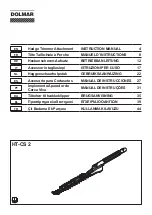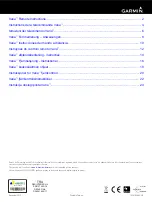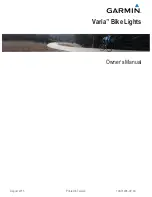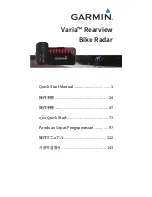
Work area safety
WARNING:
Keep the hedge trimmer away from electric
lines and communication cables. Touching or approaching
high-voltage lines with hedge trimmer can result in death or
serious injury. Watch power lines and electrical fences around
the work area before starting operation.
WARNING:
Use of this product can create dust containing
chemicals which may cause respiratory or other illnesses.
Some examples of these chemicals are compounds found in
pesticides, insecticides, fertilizers and herbicides. Your risk
from these exposures varies, depending on how often you do
this type of work. To reduce your exposure to these chemi-
cals: work in a well ventilated area, and work with approved
safety equipment, such as those dust masks that are specially
designed to filter out microscopic particles.
1. Operate the hedge trimmer under good visibility and daylight
conditions only. Do not operate the hedge trimmer in darkness or
fog.
2. Start and operate the engine only outdoors in a well ventilated
area. Operation in a confined or poorly ventilated area can result
in death due to suffocation or carbon monoxide poisoning.
3. During operation, never stand on an unstable or slippery surface
or a steep slope. During the cold season, beware of ice and
snow and always ensure secure footing.
4. During operation, keep bystanders or animals at least 15 m away
from the hedge trimmer. Stop the motor as soon as someone
approaches.
5. Before operation, examine the work area for wire fences, stones,
or other solid objects. They can damage the blades.
Putting into operation
1. Before assembling or adjusting the equipment, switch off the
motor and remove the spark plug cap or the battery cartridge.
2. Before assembling the blades or adjusting the cutting angle,
wear protective gloves.
3. Before starting the motor, inspect the equipment for damages,
loose screws/nuts or improper assembly. Replace if the blades
are cracked, bent, or damaged. Check all control levers and
switches for easy action. Clean and dry the handles.
4. Never attempt to start the motor if the equipment is damaged or
not fully assembled. Otherwise serious injury may result.
5. Adjust the shoulder harness and hand grip to suit the operator’s
body size.
Operation
1. In the event of an emergency, switch off the motor immediately.
2. If you feel any unusual condition (e.g. noise, vibration) during
operation, switch off the motor. Do not use the hedge trimmer
until the cause is recognized and solved.
3. The blades continue to move for a short period after releasing
the throttle trigger or switch off the motor. Don’t rush to contact
the blades.
4. With the engine running only at idle, attach the shoulder harness.
5. During operation, use the shoulder harness. Keep the hedge
trimmer on your right side firmly.
►
Fig.2
6. Hold the front handle with the left hand and the rear grip with the
right hand, no matter you are right-hander or left-hander. Wrap
your fingers and thumbs around the handles.
7. Never attempt to operate the equipment with one hand. Loss of
control may result in serious or fatal injury. To reduce the risk of
cut injuries, keep your hands and feet away from the blades.
8. Do not overreach. Keep proper footing and balance at all times.
Watch for hidden obstacles such as tree stumps, roots and
ditches to avoid stumbling. Clear fallen branches and other
objects away.
9. Never work on a ladder or tree to avoid loss of control.
10. Do not hold the machine above shoulder height.
11. During operation, never hit the blades against hard obstacles
such stones and metals. Take particular care when cutting
hedges next to or against wire fences. When working close to the
ground, make sure that no sand, grit or stones get between the
blades.
12. If the blades come into contact with stones or other solid objects,
stop the motor immediately and check the blades for damage
after removing the spark plug or the battery cartridge. Replace
the blades if damaged.
13. If thick branches get jammed in the blades, immediately switch
off the motor, put the hedge trimmer down and then remove the
obstruction after removing the spark plug or the battery cartridge.
Check the blades for damage before using the equipment again.
14. Never touch or approach the blades while they are moving.
Blades can cut your finger easily. When handling the blades or
adjusting the blade angle, stop the motor and remove the spark
plug cap or the battery cartridge.
15. Accelerating the motor with the blades blocked increases the
load and will damage the motor and/or clutch.
16. Check the cutting blades frequently during operation for cracks
or blunt edges. Before the inspection, switch off the motor and
wait until the blades stop completely. Replace damaged or dull
blades immediately, even if they have only superficial cracks.
17. If the equipment gets heavy impact or fall, check the condition
before continuing work. Check the fuel system for fuel leakage
and the controls and safety devices for malfunction. If there is
any damage or doubt, ask our authorized service center for the
inspection and repair.
18. Do not touch the gear case. The gear case becomes hot during
operation.
19. Take a rest to prevent loss of control caused by fatigue. We rec
-
ommend to take a 10 to 20-minute rest every hour.
20. When you leave the equipment, even if it is a short time, always
switch off the engine or remove the battery cartridge. The equip
-
ment unattended with the engine running may be used by unau
-
thorized person and cause serious accident.
21. Before cutting, pull the throttle lever fully to achieve the maxi
-
mum speed.
22. Follow the instruction manual of the power unit for proper use of
the control lever and switch.
23. During or after operation, do not put the hot equipment onto dry
grass or combustible materials.
Transport
1. Before transporting the equipment, switch off the motor and
remove the spark plug cap or battery cartridge. Always fit the
blade cover during transportation.
2. When carrying the equipment, carry it in a horizontal position by
holding the shaft. Keep the hot muffler away from your body.
3. When transporting the equipment in a vehicle, properly secure
it to avoid turnover. Otherwise fuel spillage and damage to the
equipment and other baggage may result.
Maintenance
1. Before doing any maintenance or repair work or cleaning the
equipment, always switch off the motor and remove the spark
plug cap or the battery cartridge. Wait until the motor gets cold.
2. To reduce the risk of fire, never service the equipment in the
vicinity of fire.
3. Always wear protective gloves when handling the blades.
4. Always clean dust and dirt off the equipment. Never use gas
-
oline, benzine, thinner, alcohol or the like for the purpose.
Discoloration, deformation or cracks of the plastic components
may result.
5. After each use, tighten all screws and nuts, except for the carbu
-
retor adjustment screws.
6. Keep the cutting tool sharp. If the cutting blades have become
blunt and cutting performance is poor, ask our authorized service
center to sharpen the blades.
7. Never repair bent or broken blades by straightening or welding.
It may cause parts of the blades to come off and result in serious
injury. Contact our authorized service center for Dolmar / Makita
genuine blades to replace them.
8. Do not attempt any maintenance or repair not described in this
booklet or the instruction manual of the power unit. Ask our
authorized service center for such work.
9. Always use Dolmar / Makita genuine spare parts and accesso
-
ries only. Using parts or accessories supplied by a third party
may result in the equipment breakdown, property damage and/or
serious injury.
10. Request our authorized service center to inspect and maintain
the hedge trimmer at regular interval.
Storage
1. Before storing the equipment, perform full cleaning and mainte
-
nance. Fit the blade cover.
2. Store the equipment in a dry and high or locked location out of
reach of children.
3. Do not prop the equipment against something, such as a wall.
Otherwise the hedge trimmer may fall suddenly and cause an
injury.
First aid
1. Always have a first-aid kit close by. Immediately replace any item
taken from the first aid kit.
2.
When asking for help, give the following information:
5 ENGLISH






































